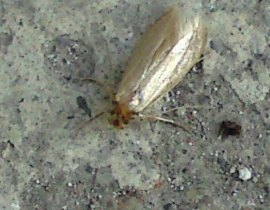Professional Pest Control & Wildlife Management
Common Clothes Moth
The Clothes Moth Tineola bissellaiella has long been associated with destroying priceless garments but is equally adept at ruining carpets and furniture. The adult moths are not responsible for any of the damage associated to them, it is infact the larvae stage which chews through natural fabric materials.
If you think you have a clothes moth infestation in your home and you would like to make an appointment, ask advice or have any questions please use our contact form.
-
Risks
The risk of leaving a clothes moth infestation untreated is for them to eventually eat your entire carpet and all your clothing and soft furnishings. Once you have discovered an infestation it should be brought under control immediately to prevent it spreading throughout the property.
Clothes moth larvae will literally eat holes in carpets; this damage usually occurs underneath rarely moved furniture. Once discovered the amount damage can be quite substantial.
-
Treatment
The first aspect of an effective treatment is to locate the source of the infestation, removing – if possible affected articles to be disposed of or treated separately.
A good strong residual insecticide will take care of the larvae, however any moth in the egg stage will likely not be affected by the treatment. A follow-up treatment is often advised to ensure complete eradication.
All furniture will require moving to allow technicians to apply the insecticide to all floor areas and around all carpet edges.
Its advisable that all clothing and soft furnishings in affected areas should be either frozen or washed at a temperature above 60 degrees.
-
Life Cycle
The female moth lays around 50 eggs to a suitable material the larvae can feed upon. Eggs hatch within 10 days in warm weather and reach adulthood in just over a month but can take significantly longer, years longer in fact.
The larvae have dark heads and white bodies. They usually spin themselves a silken case and attach frass (excrement, material fibres, dust, etc.) and lie inside feeding upon the protein found in animal fur and feathers.
- False Widow Spider Removal
- Cluster Fly help
- The trouble with fleas?
- Mole Catching in Suffolk
- Rats in the Garden
- Wasp Nest Control
- Rats in your chicken Coop
- Anaphylaxis
- Bee Swarms
- Honey Bee Relocation
- Rare Breed Poultry
- Pest Control with Birds of Prey
- Un-marked vehicles available
- Rabbiting with Ferrets
- Myxomatosis
- Poll-Tex Mesh
- Honorary Member Russell Wallis
- Free Rabbit Control


